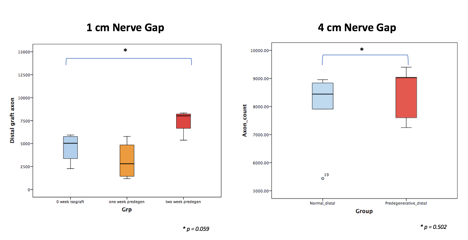Myth Revisited: Predegenerated Isografts does not Improve Nerve Regeneration Across Nerve Gaps
Johnny Chuieng - Yi Lu, MD1,2; Tsung-Kai Lin, MD3; Lauren Schellhardt, BS4; Daniel A. Hunter, RA4; Xueping Ee, MD4; Alison K. Snyder-Warwick, MD5; Susan E. Mackinnon, MD6; Matthew Wood, PhD4
1Chang Gung Memorial Hospital, Linkou Medical Center, Taoyuan, Taiwan, 2Washington University in St. Louis, St. Louis, MO, 3Chang Gung University and Medical College, Taoyuan, Taiwan, 4Washington University School of Medicine, St Louis, MO, 5Washington University School of Medicine, St. Louis, MO, 6Department of Surgery, Division of Plastic and Reconstructive Surgery, Washington University School of Medicine, St. Louis, MO
Introduction
Autografts are the gold standard to bridge a nerve gap, but long autografts (>3cm) have limits to promote regeneration. Recently, we determined regeneration may be impeded by a long autograft's microenvironment. Specifically, we found an association of decreased early axon regeneration and increased senescent Schwann cell (SC) accumulation within long rat isografts. To further investigate this relationship, we bridged nerve gaps using “predegenerated” isografts, which contain already dedifferentiated SCs that promote earlier axon growth and may impact senescent SC accumulation. Our aim was to evaluate the effectiveness of predegenerating nerve to promote regeneration and potentially improve the capabilities of long nerve autografts to treat nerve gaps.
Materials and Methods
Predegenerated isografts were harvested by first cutting proximally at the L4-L6 roots level of donor Lewis rats two weeks prior to harvest. In different rats, a sciatic nerve gap was bridged using these harvested grafts and compared to control isografts harvested without prior injury (no predegeneration). Gaps were bridged by either short (1 cm) or long (4 cm) grafts. Nerve regeneration was assessed using histology, muscle mass, immunohistochemistry for neuromuscular junction imaging, muscle contraction force, and walking track analysis at variable endpoints.
Results
Early preliminary results indicated 1 cm predegenerated isografts facilitated more robust axon regeneration across the graft. Axon counts in the distal nerve trended significantly higher for predegenerated isografts (7436 +/- 1386) compared to control isografts (4568 +/- 1654; p=0.059) in a pilot study. However, 4 cm predegenerated isografts did not improve regeneration compared to control isografts (Figure 1). Between these groups, there were no significant differences in axon counts, muscle mass, muscle contraction force, behavior testing, or functional innervation at the motor end plates. Evaluation of early axon regeneration and the accumulation of “repair” SCs, senescent SCs, and inflammatory markers within the long isograft groups is pending.
Conclusions
Predegenerated isografts showed potential to promote enhanced axon regeneration across short nerve gaps. However, this potential did not translate to improved regenerative potential to overcome the limitations in longer nerve grafts.
Figure 1 Analysis of myelinated axon numbers in nerve distal to short or long grafts.
Back to 2019 ePosters
